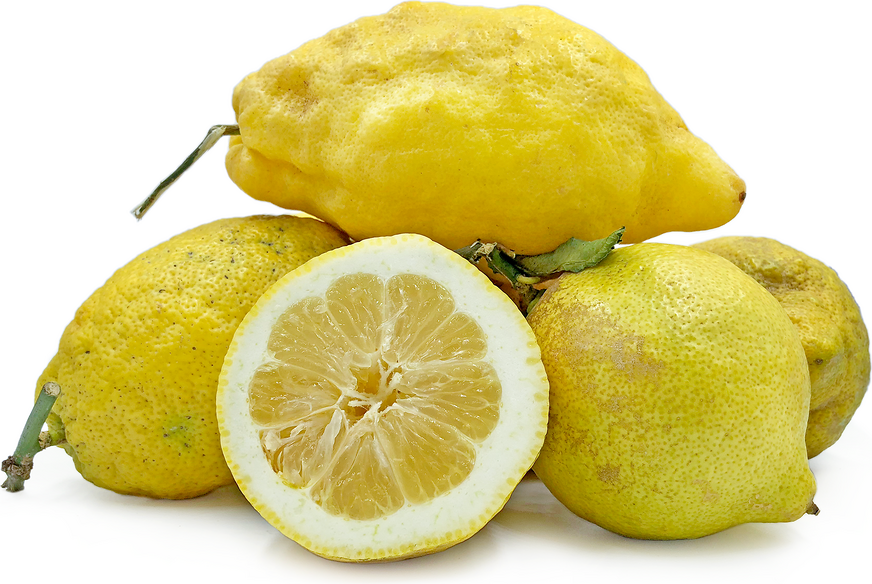


Zest Lemons
Estimated Inventory, lb : 0
Description/Taste
Citron is a type of citrus fruit characterized by its lumpy, elongated body. Its oblong shape can look like a regular lemon or be much more irregular. The Citron's skin is similar in color to a lemon but rugged and more wild-looking, sometimes featuring vertical ridges along its body. Citrons are bright yellow with occasional remnants of green. The fruit's size can vary from 10 to 30 centimeters in length and up to 10 centimeters in width. When cut open, the Citron reveals a thick skin that constitutes 70% or more of its total mass. Beneath the yellow zest lies a soft, spongy, white pith known as albedo. The inner flesh is segmented into small light yellow slices laden with seeds, comprising a smaller portion of the fruit compared to other citrus varieties. Although the pulp is minimal, relatively dry, and provides little juice, its deep oil glands emit a potent citrus aroma. The flavor of the Citron is markedly less sweet and less acidic than that of oranges or lemons. The juice is mild and somewhat bitter, while the peel offers a slightly sweet, tangy taste.
Seasons/Availability
Citrons are available from November to January.
Current Facts
The botanical name for Citron is Citrus medica, and it belongs to the Rutaceae family. Greek scholar and philosopher Theophrastus once referred to it as Citrus Media and Median Apple, though these names aren't commonly used today. There are several cultivars of Citron, including the fingered 'Buddha's hand', the Italian 'cedri' or 'cedro', 'Florentine', and the popular 'Diamante'. Historically, Citron was valued for its fragrant peel and its medicinal uses, helping with seasickness, respiratory issues, and stomach problems. People even mixed Citron juice with wine as they believed it was an antidote for poison. The essential oil from the peel was thought to combat ailments like pneumonia, bronchitis, impetigo, and salmonella thanks to its antibiotic properties. Citrons are one of the four original citrus types along with pomelos, mandarins, and the lesser-known papeda. While "zest lemons" isn't a specific variety, the term is generally used for various types of Citrus medica. The essential oil of Citron, extracted by cold-pressing the peel, is made from the most nutrient-dense part of the fruit and is rich in fat-soluble phytonutrients. This oil is versatile and used in non-toxic cleaning solutions, insect repellents, and to neutralize unpleasant odors.
Nutritional Value
A significant portion of Citron’s nutritional benefits come from its skin or zest, which is rich in essential oils and phytonutrients. Citron zest is high in vitamin C, helping protect the body against free radicals, supporting immune health, and contributing to bone strength. The volatile oils in the Citron rind, containing compounds like limonene and other terpenes, have demonstrated antimicrobial properties and may have potential antibiotic effects. Citron zest may also aid in digestion and could potentially help lower inflammation. Rutin, a flavonoid found in Citron, may contribute to collagen production, which is important for skin and connective tissue health.
Applications
Citrons are primarily valued for their zest and spongy white pith, rather than their juice. The zest can be grated or transformed into long, julienned slices or curls. A popular use of the skin is to make candied Citron by soaking the rind in sugar water and then drying it. Candied Citron plays a key role in traditional holiday panettone cake. In northern Italy, Citron is also used to make a well-known soda called 'cedrata.' Citron can flavor liqueurs such as limoncello or cedrello, which are chilled after-meal drinks served in small glasses. The Citron's pith is used in a wheatberry and ricotta cake known as pizza grana, commonly prepared around Easter. It can also be grated into salads, pastas, seafood dishes, meat marinades, salad dressings, sauces, rice dishes, and tea mixtures. Thin strips or curls of Citron zest can serve as garnishes for plates, drinks, cookies, pies, and tarts. Citron pairs well with lime, orange, grapefruit, mint, basil, thyme, rosemary, cinnamon, ginger, almonds, pistachios, walnuts, soft cheeses, chicken, pork, strawberries, blueberries, apples, and dark chocolate. Store zest lemons at room temperature for up to a week or refrigerate for up to three weeks.
Ethnic/Cultural Info
Citrons are prominently used during Jewish holidays and festivals. Specifically, Etrog Citrons are cultivated for the October Jewish holiday of Sukkot. These highly aromatic Citrons are given as gifts and are seen as symbols of the heart. They are also used in the waving rituals during the Feast of Tabernacles. In religious iconography within Hinduism and Buddhism, Citrons are sometimes held by figures of worship, such as Kubera, the lord of treasures, who is depicted holding a Citron in one of his up to six arms. In certain Hindu traditions, the Citron symbolizes prosperity. The use of citrus zest in recipes dates back to the 15th century when it became be a common ingredient for its flavoring properties. The term "zest" originated from the French word zeste in the 17th century. Before vanilla became widely available, citrus zest was an essential flavoring ingredient in French pastries.
Geography/History
Citron is believed to have originated from the region that now encompasses India and Southeast Asia, with its history dating back to as early as 4000 BC. These fruits thrive best in regions with consistently warm temperatures that are not excessively hot. Citrons began to spread worldwide when they were introduced to Greece and later Italy, eventually reaching the rest of the Mediterranean through various ancient trade routes. Today, Citron production occurs in the Mediterranean, Southeast Asia, Israel, Italy, Southern California, and Florida. Citrons are typically cultivated in orchards or gardens rather than growing in the wild. They are often found in specialty stores within communities where Citron is an integral part of traditional cooking or cultural practices, such as in Jewish, Hindu, or Buddhist communities.
Recipe Ideas
Recipes that include Zest Lemons. One




